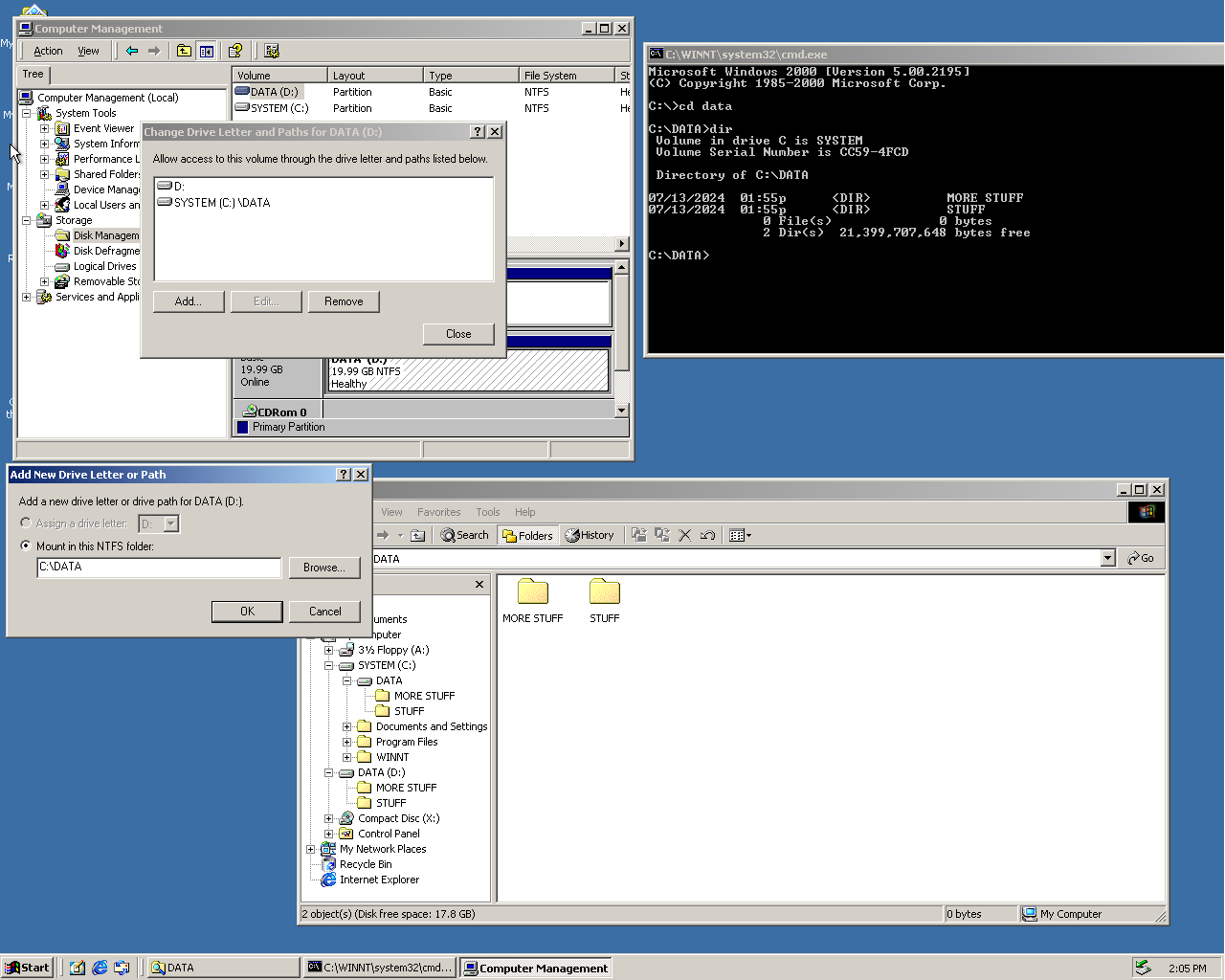When is an ad an advertisement and not a recommendation? Microsoft clearly likes to use the term recommendation for what others may see as an advertisement.
There are recommendations in the Start menu, Settings app, Lock screen, File Explorer, Get Help app, and other areas of the operating system already. These are often not that useful. App recommendations in the Start menu are limited to Microsoft Store apps.
Now, Microsoft is testing recommendations in the Microsoft Store app. If you never use the app, you won’t be exposed to these. If you do, you may notice recommendations popping up when you try to use the built-in search.
First spotted by phantomofearth on X, two or three recommendations are shown whenever search is activated in the official Microsoft Store app.
I’ve recently made the switch over to LinuxMint and I was shocked. Installing a popular Linux Distro is EASIER than installing Windows 10/11 at this point. Seriously. The Linux installer is super noob friendly, very quick and straight to the point, it doesn’t need you to create an online account and you don’t need be wary of accidentally giving any corporation the rights to steal your data.
And all the software I use (Steam, Discord, Spotify, Firefox, Thunderbird, …) were all downloadable from the GUI Installer and worked right away OUT OF THE BOX. No fiddling in any Terminal was required.
Seriously, it’s easier than installing Windows at this point.
Installing Linux has never been particularly difficult, not in the last 15 or even 20 years anyway. I’ve always found it easier and more straightforward than the contemporary Windows installation process.
The challenging part is wrapping your head around the Linux/Unix way of doing things when things can’t be done through the GUI with just a few clicks.
I know the filesystem is simple to Linux users, but the semantic form of physical drives getting a letter always made more sense to me.
I have three drives in my computer. So they’re labeled C:, D:, and E:. You can’t place a file on “The Computer” - it’s stored on some particular drive. If I install a game on the E drive, and then later somehow remove that drive and bring it somewhere else, that game remains on that drive, even if it’s no longer E.
On Linux, as best I understand it, if I have three drives, two of them are at /dev/hdd0 and hdd1. But they’re not actually there, they’re accessed at /media/hdd0 after mounting them (or at least, that’s the convention, and if it’s someone else’s computer, good luck). Then you either begin every game installation path with that annoying prefix, or you start configuring a dozen symlinks. If you place an item in /home/documents/notporn, then who knows which drive it’s on because you don’t know what symlinks someone set up to make that folder.
Windows does have symlinks too now, which has been nice for hacking a few installation directories, but I appreciate that it’s an exception, and everything else follows relatively logical division of space, rather than this hybrid system where the filesystem isn’t just stored files but also devices, programming concepts, and more.
I know the filesystem is simple to Linux users, but the semantic form of physical drives getting a letter always made more sense to me.
That’s one of the things that semi-experienced Windows users need to wrap their head around, but I strongly disagree that drive letters are somehow inferior to a hierarchical file system structure. I mean, the A:, B:, C: … convention was originally just intended for the first IBM PC with 1 or 2 floppy drives. It was never intended to support complex storage configurations, whereas the hierarchical file system was designed for Unix systems that had to handle multiple magnetic drives from the start. It is a much more flexible system to organize your file storage.
On Linux, as best I understand it, if I have three drives, two of them are at /dev/hdd0 and hdd1. But they’re not actually there.
That’s because there is a difference between a block device and a mounted file system. Windows just obscures that difference from you with its archaic drive mapping system.
All your block devices and partitions on your block devices will be in
/devwith a meaningful name. You can list them with thelsblkcommand. If a partition contains a file system that Linux knows how to use, you can mount it anywhere you like.they’re accessed at /media/hdd0 after mounting them
No that’s not “convention” at all. Some desktop environments may decide to mount undefined drives there, but there really is no convention, ultimately you mount it where you want it to be mounted.
If you place an item in /home/documents/notporn, then who knows which drive it’s on because you don’t know what symlinks someone set up to make that folder.
If your unsure,
df /home/documents/notpornshould tell you exactly what drive it’s on, but ultimately it’s up to you to know how you’ve organized your storage.BTW I’ve said this before, but Linux is probably harder for users who know Windows just well enough to be dangerous than it is for relative beginners, because there are so many concepts and things they take for granted that they have to unlearn.
As an interesting fact, windows totally supports mounting positions to folders and as far as I recall it’s been able to for a very long time, remember doing it as a teenager and thinking it was cool AF.
https://learn.microsoft.com/en-us/windows-server/storage/disk-management/assign-a-mount-point-folder-path-to-a-drive And https://learn.microsoft.com/en-us/previous-versions/orphan-topics/ws.10/cc772671(v=ws.10)
Yeah, I believe that was introduced as far back as Windows 2000. It never really caught on though.
I think I did it back in xp, I was trying to figure out when support was added.
I don’t think it’s super advertised that it’s a capability which definitely doesn’t help its usage, heck I kinda forgot about it even though I used it until your comment triggered a memory.
I just booted up a Windows 2000 VM to check … it’s there in the disk management tool. It looks a bit weird with the drive icon in Explorer, but ok.

While it might be suitable for server environments with 400+drives, all home setups will have fewer volumes than there are alphabet letters, so it’s a suitable setup there.
Someone else identified how you can run an extra command to identify actual location of a file, and while that’s useful, it’s an extra step that’s unnecessary when the design of the location string itself also identifies that. Unless you can tell me which drive /home/supra-app/preconfiguration/media is on - without running something different. (Vs windows: C:/Users/Someone/AppData/supra-app/preconfiguration/media) That’s what the design of WWW URLs was for - you never have to ask which domain a website is on, and it can even inform you about whether a site is trustworthy.
I don’t think you’re helping your case by showing there’s no drive location convention at all. A friend plugs a USB device in your computer while you’re busy in the kitchen. He’s fine if he just uses a UI autopopup, but if he needs the full path, he has to ask you where you’ve set up auto-mounting, if you have at all.
The thing is, you are absolutely free to use a
/c,/d,/emounting scheme, but you are not shackled to it like you are in Windows. Personally I like to organize my data in one big root (/) file system on my NVME drive and then/datafor my bulk storage on HDD and/nasfor my NAS shares. I never have any problems knowing where my data is.BTW, I notice all your complaints revolve around “OMG it’s different” and “OMG the user can choose to do things differently… so complicated”. That is kind of the point of Linux you know?
At some point you just have to accept that it’s different and move on, or decide that it’s too complicated for you and use something else.
BTW, I wonder why people never make this complaint about Apple devices? It also has a hierarchical file structure without drive letters, after all it is also a Unix variant.
The dog whistle of “maybe it’s not for you” is pointless, since all we’re doing here is talking about preferences and opinions of design. Whether something is “complicated” or “poor design” is very subjective across many fields. It’s easy to laugh at someone pushing at a “Pull” door, but less so if there’s a pushbar there and they don’t speak English.
I could easily be facetious and suggest “Maybe Windows is just too complicated for you” but that’s similarly needlessly talking down to people’s intelligence. The topic only came up because it’s frustrating there’s no operating system out there that:
- Has wide support
- Doesn’t nag you with AI features
- Designs its filesystem paths in a way that is consistent, informative, and readable between devices, regardless of user preference or configuration.
For now, issues like the last one are what keep me on Windows, and I’m not even claiming they’re easy to solve.
Well keep dreaming then. If that is what keeping you on Windows, you will never leave Windows. Nobody in their right mind is ever going to create a new OS with drive letters.
/thread
People need to stop complaining about the ads and they need to start complaining about the existence of a Windows monetization team.
Kill that team now while the revenue is small and the shareholders won’t throw a giant hissy fit.
As long as that team exists, they’re going to be putting ads in shit. Cut the head off the snake.
Microsoft put themselves in this position when they started giving out Windows 10 for free. It was effective in bringing most of the market onto the new version, but it set an expectation which it now feels like they can’t break, so they’re also giving Windows 11 away. Now to offset that missing revenue, they have to do something to extract value from users.
I don’t see how they could stop this without replacing it with something more exploitive.
There is nothing free in this life…
Linux is free.
Monetarily yes, but not free of time, in fact time it’s the most precious resource we have.
A one-off time ‘investment’ of switching to Linux will save you from all future cases of searching for how to wrestle with the latest Windows crapware. If you switch, you’ll be in time-debt for a few months, and after that you’ll be ahead - and you’ll stay ahead indefinitely. You’ll also have the piece of mind that you are not being spied on and monetised by your OS.
Personally I use Linux, and TBH as I value my free time it’s why I say it, if you need something that just works and don’t want to mess around looking for fixing trivial errors on the internet I would suggest using windows to 95% of people, I hate windows but I must admit if it’s about stability at exchange of looking ads with not tech ability definitely it’s the most recommended.
Linux it’s amazing but it’s not for everyone.
It’s like the eternal battle Apple VS Android, if you just want it to work and don’t want to mess around with trivial errors definitely Apple it’s the choice, you lose liberty and privacy but for most people it will work fine.(I use Android)
Are we speaking metaphorically or literally? sharpens blades
Yes
The ads are in the app store. I don’t really understand why that’s a problem. Although I’m probably the only tool out there that actually likes Windows 11.
lol yep you probably are
Is Microsoft so in debt that they need to sell ad space in every pixal of their products? What is going on.
Debt? This is capitalism, baby. Where every year’s profits have to be bigger than last year’s or else it counts as you failing, no matter how enormous the profits were last year.




